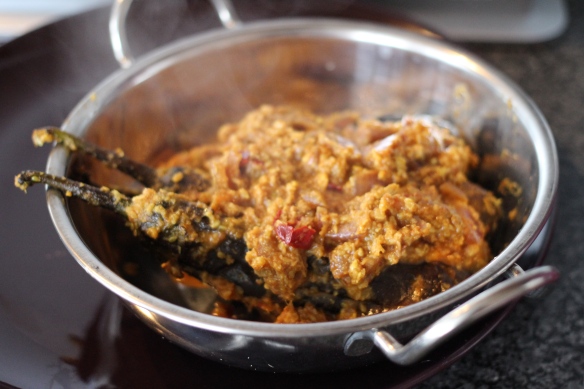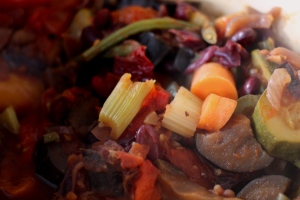My entry into Indian cooking really began with Rick Stein’s book ‘
Rick Stein’s India‘, after watching the series and deciding that I wanted to try and make some of the dishes. The recipes were clear, and the results have been great more or less every time. A favourite has to be
chana masala (a chickpea curry) – I never thought one of my favourite foods would be a tomato and chickpea dish. But anyway, I’ve now cooked so many of the recipes from there that I wanted to try something different. I first discovered what Bagara Baingan was after visiting Exotic Dining restaurant in Kettering, my home town. We met a friend there for dinner a couple of years ago and the food was
wonderful – of all the years I lived in the that town I hadn’t even realised the restaurant was there, and the sign outside really doesn’t do the food justice. My usual dish until recently would have been the murgh methi, a chicken based dish, but for some reason I decided to order something from the vegetarian section – Hyderabadi Bagara Baignan. According to
saffron streaks:
Bagara means tempering the oil with spices, a traditional Indian practice of cooking to enhance the aroma of a dish. The recipe uses the small types of aubergines (brinjal) that you should be able to find in larger supermarkets or if you live in a city like Coventry, the central market should have them (once again Coventry market has been my first port of call for getting ingredients I need for my year of global cooking). There are lots of different versions of the recipe available online and I have decided to go for an adapted version of the
recipe from the blog
Edible Garden. Already this year, by looking for cooking inspiration I have found so many great cooking blogs – I should compile a list at some point.
Bagara Baingan
(Serves two people)
Ingredients:
- 6 baby aubergines
- 2 tbsp sesame seeds
- 2 tbsp peanuts (red skinned)
- 2 tbsp dessicated coconut
- 1 onion, finely chopped
- 1 inch piece of ginger
- 2 garlic cloves
- 1/4 tsp turmeric powder
- 1 tsp cumin seeds
- 1 tbsp coriander powder
- 1 tsp kashmiri chilli powder
- 1 dried kashmiri chilli (finely chopped)
- A small lemon sized ball of tamarind
- 1 tbsp oil
- Salt

Method
- Dry roast the peanuts and sesame seeds separately until golden brown. Set aside to cool. Then, blend together with the coconut and little water to form a smooth paste.
- Extract the tamarind paste in 1 cup warm water. Grind the ginger and garlic (or mash in a pestle and mortar).
- Fry the aubergines in 1 tbsp of oil until soft but still hold their shape (about 10 minutes). Drain and set aside.
- In the same oil, fry the onions and ginger garlic paste until golden. Then add the ground paste and fry for a minute.
- To this, add turmeric powder, chilli powder, coriander powder and salt. Mix well and fry for another minute.
- Add the tamarind water, mix, then add the aubergines and cook closed for 5-10 mins.
It’s usually served with roti or rice, but we had it with naan bread. If you have any fresh coriander you could sprinkle some of that on top too.
 This weekend I was looking for a vegetarian dish that would use up some of the vegetables we had left in the fridge, and helpfully I found a recipe from A Lebanese Feast that did just that. This was a Lebanese recipe that was basically a vegetable stew, and it suggests you can substitute the vegetable as you wish. I actually had pretty much what the recipe suggested, so just a few alterations. But this really was one of the easiest things I have cooked for a while; literally fry the onions and garlic and then add everything else and let it cook down in its own juices which produce an incredibly flavour.
This weekend I was looking for a vegetarian dish that would use up some of the vegetables we had left in the fridge, and helpfully I found a recipe from A Lebanese Feast that did just that. This was a Lebanese recipe that was basically a vegetable stew, and it suggests you can substitute the vegetable as you wish. I actually had pretty much what the recipe suggested, so just a few alterations. But this really was one of the easiest things I have cooked for a while; literally fry the onions and garlic and then add everything else and let it cook down in its own juices which produce an incredibly flavour.













